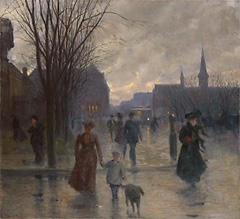Curriculum Materials: Art in America
|
|
Image 16 Robert Koehler Questions: |
Think Questions Teacher Key
1. If you could enter this scene, what sounds would you hear? What might you smell?
2. What can you deduce about downtown Minneapolis in 1902 by studying this painting?
3. The artist, Robert Koehler, was influenced by a French STYLE called IMPRESSIONISM. What is an impression? What about this painting is impressionistic? (The artist is more interested in showing the overall appearance of the scene than individual objects and people; he leaves out details of faces, clothing, and buildings, which we wouldn't see on a foggy evening; he shows a fleeting moment.) How does Koehler's use of loose, visible BRUSHSTROKES enhance the sense of an impression in this painting?
4. Why did Koehler make the people and objects in the FOREGROUND larger than those in the BACKGROUND? (To create the illusion of depth.) Why did he make the buildings in the background bluer than those in the foreground? (Also to create the illusion of depth.)
5. Why do you think Koehler included his wife, son, and dog in this picture? If you created a picture of your hometown, would you include any members of your family? Why or why not? Would you include your friends? Koehler also includes his workplace, the Minneapolis School of Fine Arts, then housed in the public library. What buildings or institutions would you include in your picture in order to tell viewers something about yourself?
6. Compare and contrast Robert
Koehler's Rainy Evening on Hennepin Avenue, Georgia
O'Keeffe's City Night, and James van DerZee's Harlem Couple.
What aspects of urban development does each artwork address?
How do you think each artist feels about city life? What
makes you think so? In which picture(s) is the city the most
important element? In which are the people most important?
What makes you think so? Why do you think each artist chose
to represent the city at the time of day he/she did?
|
|
